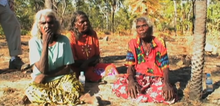Marringarr language
| Marri Ngarr | |
|---|---|
| Matige | |
| Native to | Australia |
| Region | Daly River |
Native speakers | 8 Marri Ngarr (2006 census)[1] 2 Magati Ke (2009) |
Western Daly
| |
| Dialects |
|
| Language codes | |
| ISO 639-3 | Either:zmt – Marri Ngarrzmg – Marti Ke |
| Glottolog | mari1418 |
| AIATSIS[1] | N102 Marri Ngarr, N163* Magati Ke |
| ELP | Marringarr |
Marri Ngarr (Maringarr, Marenggar, Maringa) is an Australian aboriginal language.
Marti Ke (Matige, Magati-ge, Magadige, Magati Gair, Mati Ke) lays in the similar language category.
Geographic distribution
The language has been spoken in the Northern Territory, Wadeye, along Timor Sea,[2] coast south from Moyle River estuary to Port Keats, southwest of Darwin.[3]
Current status

According to the Language Database, as of 2005 Mati Ke language had a population of 3 (Patrick Nudjulu, Johnny Chula, Agatha Perdjert).[2][4] Mati Ke speakers have primarily switched to use of English and the flourishing Aboriginal language Murrinh-Patha.[2] The ethnic population is about 100, and there are 50 second language users.
As the language is almost non-existent to date, linguists have been working on collecting information and recording the voices of the remaining speakers.[2]
Grammar
The vocabulary is limited, therefore the relations and positioning of the words matter to make sense of the construction according to the situation.
Nouns' classification constitutes a core of the language that forms an understanding of the world for its speakers. There are 10 classes amongst which are places and times, speech and language.
Reference to the class of spirits, elderly or to the people with respect is composed of prefix me+noun.[2]
Examples
- a wayelh = lizard
- dhan gi = prawns
References
- ^ a b N102 Marri Ngarr at the Australian Indigenous Languages Database, Australian Institute of Aboriginal and Torres Strait Islander Studies (see the info box for additional links)
- ^ a b c d e Abley, Mark (2003). Spoken Here: Travels Among Threatened Languages. Toronto, ON: Random House Canada. ISBN 0679311017.
- ^ "Marti Ke". Ethnologue. Retrieved 2015-12-14.
- ^ "The Language Database - Mati Ke". www.hermanboel.eu. Retrieved 2015-12-14.
